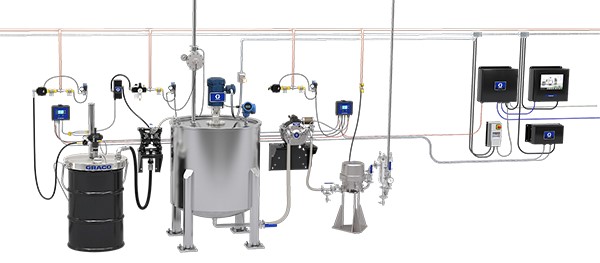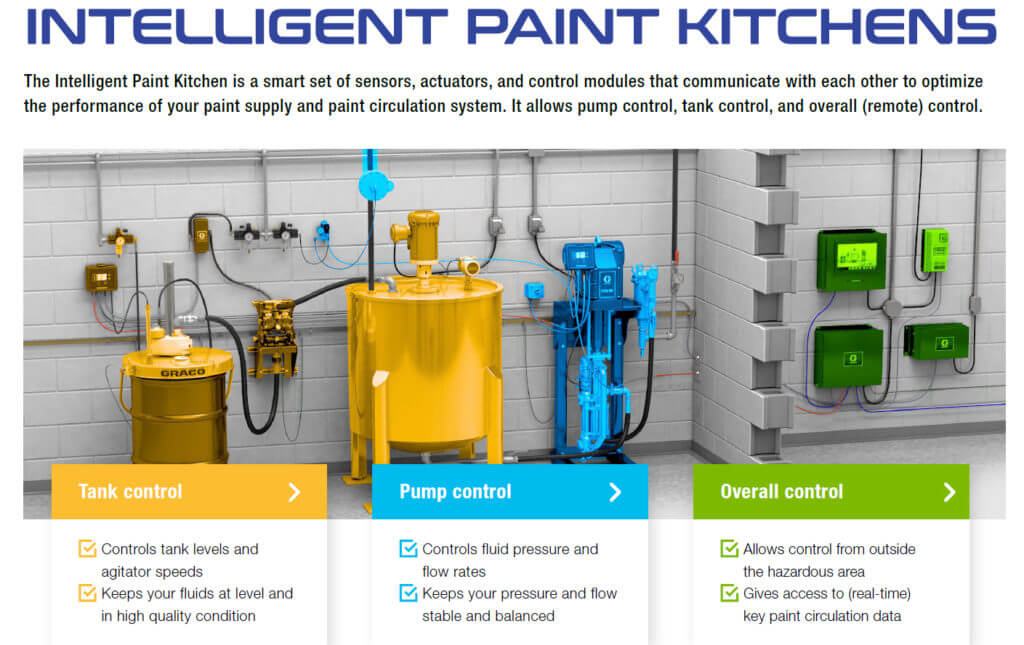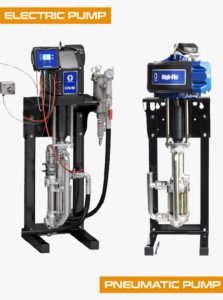September 1, 2020
Intelligent Paint Kitchens
SHARE THIS POST

Many factors impact paint finishing quality before material ever comes out of a spray gun. Some examples include material dynamics, inlet suction conditions, pump cycle rates, pump designs, viscosity, pressure fluctuations, circulating line size, velocity, shear, agitation, temperature, and humidity; just to name a few. The more control you have over these factors, the better the finish quality you will produce. Intelligent paint kitchens offer you full control of your paint mix room, from start to finish.
What are Intelligent Paint Kitchens?
Intelligent paint kitchens (IPK’s) are innovative, automated systems that monitor and control your paint mix room. They use a smart set of sensors, actuators, and control modules that communicate to optimize your paint supply and paint circulation systems. It allows users pump control, tank control, and overall remote control.

Benefits of Intelligent Paint Kitchens
IPK’s offer unprecedented benefits compared to manually operating a paint mix room, including:
- Superior quality finishes: Smoother pump operations, flow, and pressure control lead to high-quality finishes. Also, smart sensors, monitoring, and easy adjustments maintain consistency in your paint operation. Lastly, control of paint flow and pressure reduces paint shear, keeping the material in optimal condition.
- Increased efficiency: Plug-and-play software means easy start-up and operation. The modular and scalable design allows you to add components as needed and as your budget allows. Less human intervention and maintenance make your operation both safe and more efficient.
- Advanced control capabilities: Remote monitoring of your painting operation means all the data can be stored and visualized, allowing you to track and analyze every step of your process.
- Reduced costs: IPK’s offer you maximum control of your paint mix room, leading to increased savings on materials and maintenance. Also, investment and installation costs tend to be much lower than custom-built systems.
- Maximum productivity: IPK’s minimize unexpected downtime. The system can run on its own, continuing to collect data and adjust parameters accordingly without human intervention. IoT and Industry 4.0 ready.
 Electric or Pneumatic Pump Control, the Choice is Yours
Electric or Pneumatic Pump Control, the Choice is Yours
In the past, intelligent paint kitchens were primarily limited to electric-driven paint circulation pumps. (Paint circulation pumps continuously circulates one paint color through your paint mix room.) However, recent technological enhancements for automating pump circulation and agitation allows control for pneumatic pumps and agitators to be integrated into your IPK. So, you can now choose between electric or pneumatic pumps.
Hybrid Mode
Another enhancement in Intelligent Paint Kitchen technologies has been components to maintain consistent flow rates and pressure through your circulation system, even as variables change. This is referred to as the Hybrid Mode.
An example would be a plant wherein the morning, the pumps are set for 12 cycles-per-minute (CPMs), or 1 gallon-per-minute (GPM) circulation rate. In this example, we are using material that is 100 centipoises being circulated through a 300’ x 5/8” OD tubing system. Velocity at this flow rate is roughly 80 feet-per-minute (FPM) which has been determined to be ideal to maintain proper paint suspension, acceptable shear, and proper cycle rate for the pump selected for the system. As the day heats up, and material drops in viscosity, the pumps may be running at 20 CPMs or 1.75 GPM. Pneumatic pumps drive to pressure and, because the material flowing better through the back-pressure regulator, will speed up to try to reach that pressure. At this flow rate, we are now at roughly 140 FPM through the tubing system. This may not seem like a big issue, but it can affect shear sensitive materials and change suspension dynamics, creating inconsistent quality and color of finished parts throughout the day. In addition, it is running the pumps at higher cycle rates than needed which affects maintenance intervals between repairs. Commonly, set-up people are trained to either adjust the back-pressure regulator, the air regulator to the pump, or both to re-balance as conditions change. In the hybrid mode, the pressure and flow are set, and the system automatically maintains the set points in that window. Agitator speed can also be tied into this system as well. If we want 100 RPM, we can set it to maintain that speed instead of adjusting needle valves or regulators. All of this leads to more consistent paint circulation and finished quality.
Below is a link to a video that reviews intelligent paint kitchens and these enhancements in more detail. Please do not hesitate to contact us if you have any questions, need more information, or would like an evaluation of your current paint finishing system. We can also set up a webinar with you and your team to do a virtual review of the technology and potential improvements it may offer.
Search
Categories
Get a consultation
Related Posts
The 3 Distinct Advantages of Hydraulic Powered Pumps
Recently, C. H. Reed helped a major printing operation install a new ink pumping system. The new system needed to transfer four colors of high viscosity, heat-set ink to their three presses, drawing the ink from multiple 5,000…
Simple Ways to Reduce Waste in Your Spray Finishing System
In today’s demanding manufacturing landscape, it can be convenient to adopt a “cut-costs-at-all-costs” mentality, justifying questionable means for the sake of leaner production, a lower bottom line and increased profitability. Regrettably, those efforts can interfere…
What You Need to Know About Air-Powered Pressure Washers
Pressure washers are great solutions for your average cleaning applications, but what tool do you turn to for your more challenging applications? There are many instances where it is simply impossible to use a traditional…